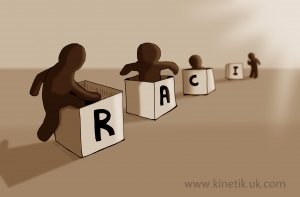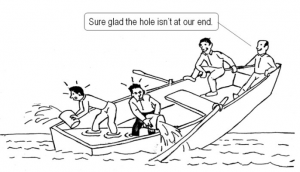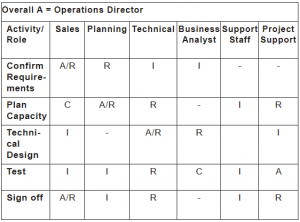
WHO WAS DOING THAT? Using RACI to clarify ownership
“You told me that the team was empowered and decided to set several objectives in the transformational programme! Now people seems to be blaming each other not meeting them!” These words could belong to a director talking to his head of transformation.
Often, during large change programmes there is a diversity of responsibilities and accountability in delivery throughout the organisation. The question “Who was supposed to be doing that?” often comes up. Blame is frequently passed around for that little job that slipped through the cracks and didn’t get done on time. RACI is a tool that fills those cracks in by aligning decision-making roles with activities around a change project. It is very easy to use and if used correctly, a sure way to bring successful change processes.
During a complex transformational change, each change team needs to be empowered to make appropriate decisions so that the team can self-regulate without needing to refer to others continuously while delivering effective, actionable results. This can only be done by giving them the power and accountability they need in order to do so. Harvard Business Review[1] recent article encapsulates by what accountability really means and according to Forbes[2], when employees feel accountable for what they do, they are more likely to go above and beyond for their organisations. There are numerous examples of change initiatives that have failed, due to a lack of proper structure around roles assigned to projects or activities.
Problems in complex change occur most often when decision-making becomes complicated due to the number of players and factors involved. Add this to a lack of clarity in accountability and you get responsibilities undone and an unstable change process. Even worse, assessing what has gone wrong fosters a blame culture in these situations.
When faced with uncertainty, many employees often prefer someone “up there” to make decisions and take calculated risks for them. More importantly, it leads to an exponential growth in unnecessary communications: issues and information are filtered up, and decisions or requests for more information are filtered down. This creates either over-involvement or no involvement, because there is no clarity in terms of who will do what.
RACI offers a solution to this problem. RACI stands for the four roles people could be involved in for any activity: Responsibility, Accountability, Consultation and Information.
Responsibility: These are the people that will do the work, or those who add value to delivery. One or more people can be responsible for one activity.
Accountability: This is the person that is accountable for the ultimate outcome of the work. They are to make sure that the activity gets done. This might even mean that they could end up doing the work themselves. Experience shows that people welcome taking accountability if they feel that they have the tools to succeed. Accountability, as a role, cannot be shared.
Consultation: These are the people that will be consulted as a part of the activity. Many organisations are weak in their ability to recognize when it is necessary to consult an expert without giving away responsibility for delivery. However, consultation with the right people is key to move forward.
Information: These are all the stakeholders that will be affected by the change and is a critical tier in transformation. They will be informed of what has happened and the decisions made during the process. Clarity in the decision of who needs to be informed and who doesn’t is crucial to prevent over-communication.
A RACI matrix should be created in a collaborative setting with visual grids and sticky notes. This way everyone can be clear of the purpose, key activities and their roles in each activity. Communicating these is very important to make sure that every individual feels comfortable with the roles.
The matrix shows an example of a RACI for delivering a technical product. The Operations Director is accountable for the overall process, ensuring that the right resources and roles are allocated to both deliver the work and for effective decision-making. Teams and roles are very clear in this matrix, and each team can see their roles for each activity. If they want, each team can even create another RACI for the activities they are responsible for in order to allocate the responsibilities within that activity, by using the matrix above as a mega RACI.
For example, the UK public body Network Rail uses a RACI chart for many for its depots, where there are both a combination of different staff trades and a host of external specialist contractors.
One thing to stay away from while preparing a RACI matrix is the temptation of ‘joint accountability.’ Two people may enjoy working together or felt that they need to share what is seen as a high-risk activity. Even though this may seem like a good idea, it should be avoided. Joint accountability dismisses the key elements of RACI, which are individual empowerment and ownership.
Finally, it is necessary to keep in mind that RACI does not necessarily drive the quality of work. It is simply a tool to align decision-making processes with the activities more effectively. Thus it is a prerequisite for RACI to ensure that the purpose or goal of the project, and its deliverables, are clear. With a clear goal, RACI can take your organisation form “Who was doing that?” to “I did that ages ago!”
More information about RACI in the context of transformational change can be found in The Art of Transformational Change by Ketan Varia.
Ketan Varia, with editorial support from Jessica Prupas and Burcu Atay
https://uk.linkedin.com/in/ketanvaria
https://uk.linkedin.com/in/jessica-prupas-3701875b
https://uk.linkedin.com/in/burcuatay
[1] Bregman, Peter. “The Right Way to Hold People Accountable” Harvard Business Review. 2016. Web. 04 Apr. 2016.
[2] Browning, Henry. “7 Ways to Build Accountable Organizations.” Forbes. Forbes Magazine. Web. 04 Apr. 2016.


